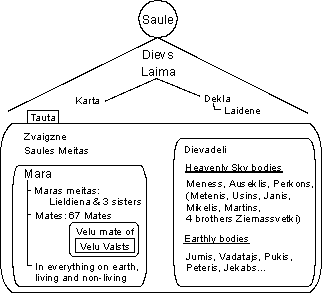Ancient Latvian Gods and Goddessses

- Dievs
- 1) Life (Saule) in Dievs (the "heart beat" of Dievs)
2) Parts that do not change: Laima, Māra (all things female)
3) Parts that can change: Dievadēli (all things male)
- Saule does not emerge as part of Dievs:
- What is Saule? Devine motive to live
Qualities of Saule: Light and sparkle. Warmth (physical and psychological)
- Parts of Dievs that do emerge in Saule
- Saules Meitas: Little saules, pilot lights, waiting to grow
Zvaigzne: Another sun. Represents the qualities of sun that sparkle and give light.
- Parts of Dievs that can not change:
- Emerge as Laima and Māra
- Laima
- Karta (Reminds us to respect all things female)
Dekla - Laidene (Reminds us if questionable nature of all things male)
- Māra
- Devine entity of Dievs found in all things on earth, living and non-living
Māras meitas - Lieldiena: Devine motive to grow
Mātes: Devine motive to nurture.
- Parts of Dievs that can change:
- Emerge as Dievadēli
Influence (help or retard) life of Dievs
| The whole |
Dievs, Vecais Tevs (God, Grandfather) |
| Fate |
Laima (Goddess of Fate)
appears as a part of Dievs
- Laima can appear as
- Dekla (The Goddess Dekla): Dekla appreciates the male influence (personality and skills) in Dievadēli and on earth. She points out that they will control the fate of Dievs.
Karkla (The Goddess Karkla): Karkla stresses the importance of respect to all things cared for by Māra (earth and all things female and femanine) to keep Dievs healthy.
Laidene (The Goddess Laidene): Visits annually, 1 week after Jāņi. Involved in choosing good marriage partner for women.
|
| Life (default, devine motive to live) |
Saule (Sun - represents Life) appears as part of Dievs
- Saule can appear as
- Saules Meitas (The Sun's Daughters): personification of Life and Fertility qualities of Saule (i.e. all things female and femanine)
Zvaigzne (Star): another sun far away
|
| Factors influencing (help or retard) life |
Dievadeli (The sons of Dievs) personify qualities of Dievs
- Heavenly Sky bodies
- Mēness (moon)
Auseklis (Morning Star)
Pūķis (Dragon) personifies paranormal events
Constellations/Light: characterized by cyclic appearance through the year. In festivals they are personified as the coming and leaving of light.
Metenis: Appears at end of winter, beginning of spring and new year
Ūsiņš: Appears at end of spring, beginning of summer. God of dawn and light. Looks after horses. (Legend that Usins is the driver of the horses that pull the sun across the sky.)
Jānis: Appears on summer solstice
Miķelis: Appears on autumn equinox. Is interpreter of celestial events. Personifies bountiful harvest.
Mārtiņš: Appears at end of autumn, beginning of winter. Driver of the sun's horses during the winter. Protects against mauranders in winter.
4 Brothers Ziemassvetki (Winter Festival): Appears on winter solstice.
- Earthly bodies
- Jumis personifies the fertilization and sowing process.
Pērkons (Thunder) personifies all weather events.
Vadātājs (leader to nowhere) personifying misguided, malfunctioning people.
Pēteris, Jēkabs appear at Hay Time. Personify skills needed to succeed.
|
| All things on earth, living and non-living |
 Māra, Māte (The Goddess Māra, Mother) appears as part of Dievs Māra, Māte (The Goddess Māra, Mother) appears as part of Dievs
- Can appear and take on many forms:
- Can appear through something tangible on earth (Mārite -ladybug, Zalkša - snake)
Can appear as Goddess of many aspects of earth:
There are 67 types of Māte (mother goddesses) under this sun.
Veļu māte of Veļu Valsts under other sun.
- Mārai Meitas (Mara's Daughters)
- Lieldiena and 3 māsas (3 sisters) appear on Spring equinox
|
Later additions during superstitious times of European Dark ages (~0 -> 1000 ad):
Ragana (witch), Velns (devil), Mājas Gars (House spirit), Vilkacis (wolf-eye)...
|

